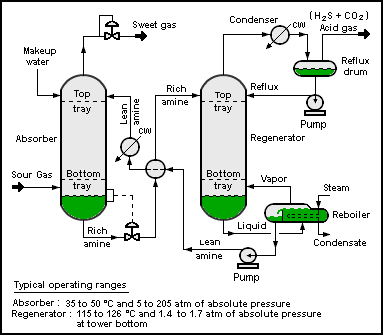Natural Gas Cleansing
In recent years demand for natural gas has grown substantially. As large, conventional natural gas deposits are extracted, the natural gas left in the ground is commonly found in less conventional deposits, which are harder to discover and produce than has historically been the case. Massive gas reserves, already identified, are too contaminated for exploitation and remain unused, too expensive to clean. Like oil, natural gas is often found underwater in offshore gas fields such as the North Sea, Corrib Gas Field off Ireland, and the Scotian Shelf near Sable Island. The technology utilized to extract and transport offshore natural gas is different from land-based fields in that a few, very large rigs are usually used, due to the cost and logistical difficulties in working over water. The Tenoroc technology is directed towards allowing for the use of known gas reserves that have high levels of contamination, reducing or eliminating the substantial risk and expense of exploration.
 Today’s Method of Natural Gas Cleansing
Today’s Method of Natural Gas Cleansing
Currently, contaminated natural gas is cleansed predominantly by percolating it through massive tanks of absorbing liquids, a method called Acid Gas Removal (AGR), or to a lesser extent by membrane filtering. AGR plants have a very large footprint, limiting their use in remote land based locations and on offshore platforms. More importantly, these plants can only process limited levels of contamination before cleansing becomes too costly. These AGR plants require a great deal of heat and energy to remove the absorbed contaminants from the absorbing liquids in a process called re-boiling. The frequency of re-boiling increases with higher levels of contamination. During the re-boiling process the volatile absorbing liquids, as well as any natural gas that was absorbed, are emitted into the atmosphere. These emissions are significant greenhouse gases that contribute to atmospheric pollution. The natural gas emissions represent lost profits. The absorbing liquids that are emitted must be continually replaced, adding to processing costs. Tenoroc’s technology addresses these environmental and financial disadvantages. Reportedly, some AGR type systems and newly developed membrane processes can process higher CO2 contamination levels than conventional AGR plants; however these systems have not found their way into the mainstream, presumably due to processing and capital expense. In addition to being able to cleanse higher levels of contamination, the Tenoroc nozzles may have the potential to improve upon or replace these current natural gas cleansing methods.
 Developing the Technology for Natural Gas Cleansing
Developing the Technology for Natural Gas Cleansing
Tenoroc used a two-component mixture of nitrogen and carbon dioxide in the course of developing the separation nozzle in a laboratory facility. The two-component mixture has characteristics that simulate many separation scenarios such as carbon dioxide separation from methane. With regard to natural gas: The principle behind the Tenoroc nozzle is that when methane contaminated by carbon dioxide (CO2) flows through the Tenoroc nozzle, the pressure and temperature drop that occur in the nozzle will cause the CO2 to change phase/condense from a gas to a liquid or solid, leaving the methane in a gaseous phase. At this point the liquid or solid CO2 will be much heavier than the gaseous methane. The tremendous gravity in the curved nozzle will force the now liquid or solid CO2 to the outside wall away from the methane, where it will be siphoned off.
The advantages of the Tenoroc technology are:
- Facilitating recovery of known non-producing natural gas reserves with massive corresponding exploration cost savings
- Ability to cleanse higher levels of contamination in natural gas
- Low capital equipment cost
- Nozzles have no moving parts
- Lower operations costs
